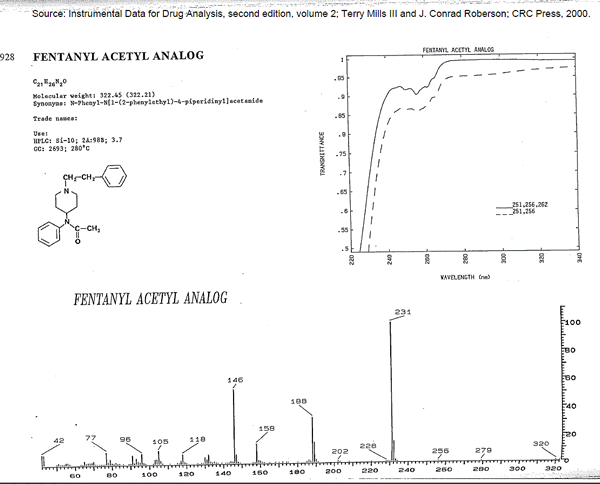Recommendations for Laboratory Testing for Acetyl Fentanyl and Patient Evaluation and Treatment for Overdose with Synthetic Opioid
Distributed via the CDC Health Alert Network
June 20, 2013, 15:15 ET 3:15 PM ET
CDCHAN-00350
Summary
Recently, a number of intravenous drug users have overdosed on a new, non-prescription injected synthetic opioid, acetyl fentanyl. Acetyl fentanyl is a fentanyl analog previously undocumented in illicit drug use that is up to five times more potent than heroin. CDC recommends increased vigilance by public health agencies, emergency departments, state laboratories, medical examiners, and coroners for patients with symptoms consistent with opioid overdose and laboratory results showing an enzyme-linked immunosorbent assay (ELISA) positive for fentanyl.
CDC also recommends that public health officials work with laboratories to carry out ELISA screens for fentanyl, and if the results of these screens are positive for fentanyl, conduct gas chromatography-mass spectrometry (GC/MS) confirmatory testing on specimens to confirm or rule out fentanyl and its analogs, including acetyl fentanyl.
Background
Since March 6, 2013, 14 overdose deaths related to a novel, injected non-prescription synthetic opioid have occurred among intravenous drug users in Rhode Island. Ten of those deaths occurred in March. On May 30, 2013, Rhode Island Department of Health confirmed that the implicated synthetic opioid is acetyl fentanyl, a fentanyl analog previously undocumented in illicit drug use. Acetyl fentanyl is not available as a prescription drug in the U.S.
The age of the persons who died from an acetyl fentanyl overdose ranged from 19 – 57 years, and 10 of the decedents were male. The toxicology testing results for most of the decedents showed, in addition to acetyl fentanyl, varying mixtures of drugs, including cocaine, heroin (morphine), ethanol, and benzodiazepines. However, none of these additional substances were present in all decedents and none of these persons tested positive for fentanyl by GC/MS after testing positive for fentanyl by ELISA. Toxicology results for one decedent showed only acetyl fentanyl (by GC/MS) and no other substances. These deaths represent a significant increase in the number of illicit drug overdose deaths compared with the number of cases typically reported in one month in Rhode Island.
There have been unconfirmed reports from other states of increases in illicit opioid-related overdose events seen in emergency departments. Media stories have associated these events with “fentanyl-contaminated heroin” or, in some cases, to fentanyl alone. It is possible that these events are related to acetyl fentanyl, but confirmatory testing is needed. States other than Rhode Island have not informed CDC that they are testing for acetyl fentanyl.
Case Definitions
- Illicit opioid-related overdose: A diagnosis by a physician of illicit opioid overdose.
Note: If a suspected illicit opioid overdose event results in death, jurisdictions often carry out drug screening. Some jurisdictions perform an ELISA that includes a screen for fentanyl, while others do not routinely screen for fentanyl. CDC recommends screening for fentanyl by ELISA to improve the detection of fentanyl-related overdose deaths. - Suspected fentanyl overdose death: An overdose death in a person who tests positive for fentanyl by ELISA screen.
Note: Some jurisdictions routinely screen for fentanyl, but do not perform confirmatory GC/MS testing. If the ELISA screen is positive for fentanyl and GC/MS confirmatory testing does not take place, an overdose death may be incorrectly attributed to fentanyl. CDC strongly encourages confirmatory GC/MS testing to determine if suspected fentanyl overdose deaths are caused by fentanyl, acetyl fentanyl, or another fentanyl analog (see case definition 3 below). - Acetyl fentanyl overdose death: An acetyl fentanyl overdose death in a person who initially tests positive for fentanyl by ELISA assay, but upon confirmatory GC/MS testing, tests positive for acetyl fentanyl rather than fentanyl. In these cases, the GC/MS results show a distinct chromatographic peak with a mass spectrum consistent with acetyl fentanyl or 4-Anilino-n-phenethylpiperdine (ANPP – a compound believed to be a precursor of acetyl fentanyl).
Recommendations
Health care and clinical recommendations:
Because of these reports of increases in illicit opioid-related overdose events, CDC encourages emergency departments and emergency response services to exercise increased vigilance in promptly identifying suspected opioid overdose patients and taking appropriate action. Because acetyl fentanyl is a synthetic opioid, it is believed that naloxone will have the same reversal effect as it does for fentanyl and other synthetic opioids. We recommend that emergency departments and emergency medical services treat suspected opioid overdoses according to standard protocols. In addition, larger doses of naloxone may be required to reverse the opioid induced respiratory depression because of the higher potency of fentanyl and acetyl fentanyl compared to heroin. CDC advises that emergency departments and emergency medical services ensure that they have adequate naloxone available, as some agencies have run out of naloxone in the face of increased numbers of overdoses and administering higher doses of naloxone in a short period of time.
Laboratory testing recommendations and additional information:
Since acetyl fentanyl might be the substance of interest in cases in which the result of the ELISA screen is positive for fentanyl but GC/MS is not conducted, toxicology laboratories should conduct both ELISA screens and GC/MS confirmatory testing on samples from illicit opioid-related overdose patients where possible. The following information can assist in identifying acetyl fentanyl.
| Chemical names: | 1. Acetamide, N-Phenyl-N-[1-(2-phenylethyl)-4-piperidinyl]- 2. Acetanilide, N-(1-Phenethyl)-4-piperidyl)- |
|---|---|
| Chemical formula: | C21H26N2O |
| Molecular weight: | 322.205 g/mol |
| CAS Number: | 003258-84-2 |
| Toxicology | |
|---|---|
| Extraction: | Recovered by routine n-butyl chloride liquid: liquid basic drug extraction, including an acid back extraction. Sensitivity of method not yet established. |
| Detection: | GC/MS EI Scan Ions 231, 146, 188 m/z and earlier eluter metabolite/breakdown ANPP 146, 189 m/z |
| Elution order: | Citalopram, ANPP, Paroxetine, ACETYL FENTANYL, Fentanyl, Zolpidem |
See chromatographic peak, mass spectrum, and chemical structure of acetyl fentanyl in the exhibit below.
Exhibit:

For More Information
Public health agencies, state laboratories, medical examiners, coroners, and emergency departments should contact CDC if they have seen any of the following:
- An increase in illicit opioid-related overdose events (morbidity and/or mortality) from January 1, 2013 to present, with or without evidence of fentanyl (see case definitions 1 and 2).
- Any individual or clusters of illicit opioid-related overdose events with evidence of acetyl fentanyl or other fentanyl analog confirmed by GC/MS (see case definition 3).
Please contact one of the following CDC epidemiologists for more information:
Matthew Lozier, PhD, MPH
Email: mlozier@cdc.gov
Phone: (770) 488-0794
Colleen Martin, MSPH
Email: CMartin5@cdc.gov
Phone: (770) 488-1468
The Centers for Disease Control and Prevention (CDC) protects people's health and safety by preventing and controlling diseases and injuries; enhances health decisions by providing credible information on critical health issues; and promotes healthy living through strong partnerships with local, national and international organizations.
Department of Health and Human Services
HAN Message Types
- Health Alert: Conveys the highest level of importance; warrants immediate action or attention. Example: HAN00001
- Health Advisory: Provides important information for a specific incident or situation; may not require immediate action. Example: HAN00346
- Health Update: Provides updated information regarding an incident or situation; unlikely to require immediate action. Example: HAN00342
- Info Service: Provides general information that is not necessarily considered to be of an emergent nature. Example: HAN00345
###
This message was distributed to state and local health officers, state and local epidemiologists, state and local laboratory directors, public information officers, HAN coordinators, and clinician organizations.
###
Additional Resources
- Page last reviewed: June 20, 2013
- Page last updated: June 20, 2013
- Content source:
- Division of Emergency Operations (DEO); Office of Public Health Preparedness and Response (OPHPR)
- Maintained By:


 ShareCompartir
ShareCompartir
